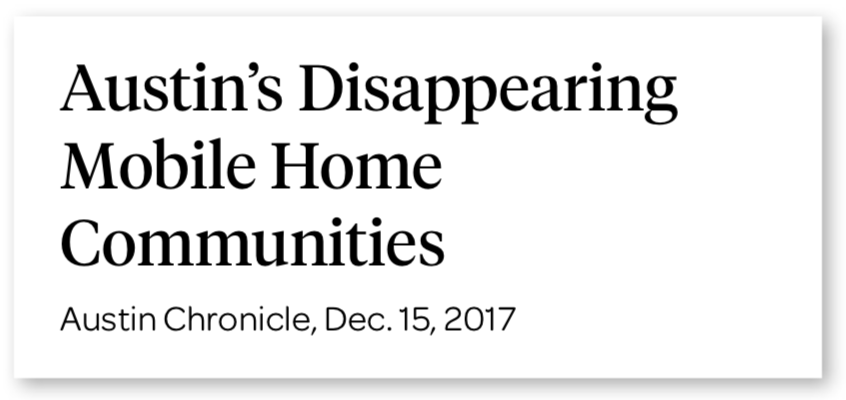Highlights
- City council rezones mobile home parks by applying a special zoning category to the parks, effectively barring redevelopment for other uses absent future council action.
- Low cost and high impact tool that helps protect mobile home park residents from displacement
Action Steps to Get Started
- Conduct inventory of mobile home parks to identify which parks do not have zoning protections that restrict redevelopment for other uses.
- City Council adopts a resolution directing staff to initiate the rezoning process for mobile home parks, so that the property can only be used as a mobile home park.
The Problem
Mobile home parks provide an important source of affordable housing for lower-income families across Texas. The parks are owned by a company or individual investor, with individual lots leased to families, typically through an annual or month-to-month lease. The family either owns or rents the mobile home on the lot.
In Texas cities, mobile home parks have historically been concentrated in low-income neighborhoods. As real estate values in these neighborhoods escalate through gentrification, the parks are among the most vulnerable properties for redevelopment. If the zoning on the property allows for more intensive residential and commercial uses, the property is especially vulnerable to redevelopment and tenant displacement. Over the years, a number of mobile home parks in Texas have been closed in areas undergoing gentrification to make way for higher-end development.

Many mobile home parks across Texas are not currently zoned as mobile home parks or related zoning category and instead have zoning that allows for other uses, thus making these properties more vulnerable to redevelopment. For example, in the City of San Antonio, only 31% of the city’s 89 active mobile home parks (as of 2019) are protected under the city’s manufactured housing district zoning—the city’s zoning classification for mobile home parks. Close to 25% of mobile home parks are zoned as commercial, and another 25% are zoned as single-family or multi-family residential. San Antonio’s manufactured housing district zoning also still allows for single-family residential uses and thus doesn’t provide as strong a protection as some other cities’ mobile home zoning categories. In Austin, prior to the City’s rezoning of several mobile home parks in 2019, a majority of the city’s 37 mobile home parks were not zoned mobile home residence districts, Austin’s zoning classification for mobile home parks.
The Tool: Applying Zoning Protections to Mobile Home Parks
Rezoning mobile home parks to a zoning category that legally restricts the property to use only as a mobile home park reduces the redevelopment risks and helps protect mobile home residents from displacement. For properties with mobile home zoning, an owner must secure a zoning change from the city council in order to redevelop the property as a different use such as luxury apartments.
The Austin Example
In 2018, the Austin City Council adopted two resolutions instructing the city manager to identify properties currently being used as a mobile home residence park or mobile home subdivision that were not zoned as a mobile home residence district and to submit the properties to the Council for initiation of zoning cases. In 2019, the Council proceeded to rezone nine mobile home parks containing 450 units as mobile home residence districts, and the rezoning of several other parks is underway.
Examples
Austin; Portland, Oregon (56 mobile home parks rezoned as Manufactured Dwelling Park uses); Kenmore, Washington; Bend, Oregon